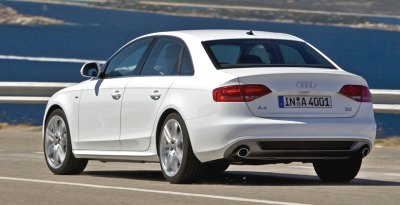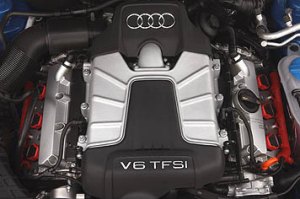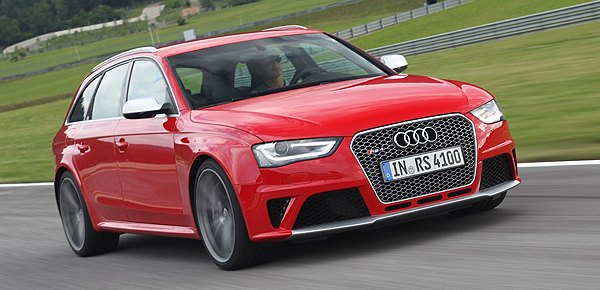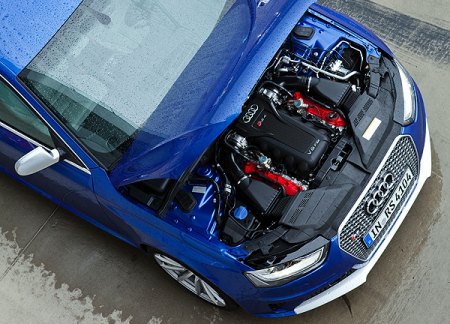Published
on 8
Nov 2007
|
All rights reserved.
|
|
|

|
With more aggression than the A5
coupe, the new A4 actually looks more sporting and attractive.
|
Since it superseded Audi
80 and
90 in 1995, Audi A4 has been steadily rising in the rank of compact
premium sedans. Last year, some 343,000 A4s found buyers worldwide,
ahead of Mercedes C-class (329,000 units) and just behind BMW 3-Series
(508,000 units). The winning formula of Audi is elegant styling and
superb build quality. In the new, third generation car, we found these
merits continue to develop. This is a very desirable premium car. It
looks tastefully designed and impeccably built. Parking beside the
3-Series and C-class, it makes its rivals looking odd. Well, you might
say these rivals are not especially good examples for styling, but when
you see how much more elegant it looks compare with Alfa Romeo 159 or
Lexus IS, you simply can't help admitting Audi has the very best
styling department in the industry. The Italian always shines in
inspiration, but only Audi has the necessary attention to details and
quality control to finish the design up to the highest standard.
The cabin is another trump card of Audi. Nothing else in this class
achieves the same level of material quality, solidity and tasteful
style. All switches have a tactile feel to operate. For higher spec
models there is a classy B&O sound system and MMI multimedia
control system, which is more initiative to use than most other systems
around (especially BMW's i-Drive). Cabin space is also remarkable for
the class. Previously, A4 used to be short of shoulder room and rear
legroom. Now the car grows significantly larger – some 117 mm longer,
54 mm wider and the wheelbase is stretched by 160 mm to a class-leading
2808 mm (note that here the "class" does not include the super-roomy
Ford Mondeo, as it is not deemed to be a "premium" car). This actually
make the new A4 closer to the territory of A6. Rear passengers are now
benefited by 36 mm of extra legroom. Access to the cabin is also made
easier by lengthening the rear doors. Besides, all passengers enjoy
more headroom and shoulder room, while luggage space is increased to a
remarkable 480 liters. Audi pushes BMW and M-B to the boxing corner.

|
New drivetrain layout improves its
handling a lot, though still not as good as those rear-wheel-drive
rivals...
|
However, when comes to driving dynamics, the new A4 still trails its
rivals from Munich and Stuttgart. Audi claims that its new ML (Modular
Longitudinal) platform from A5 has cleverly solved the long-existing
problem of nose-heaviness. This is done by relocating the clutch to
behind the front transaxle, thus allowing the longitudinal engine to
move backward by a precious 15 cm. The new platform also puts the
battery to the boot to improve balance. Moreover, in the case of
Quattro models, the new Quattro system has its Torsen limited slip
differential sending 60 percent power to the rear wheels under normal
driving so to give a rear-bias attitude and feel. Let me say in this
way, Audi's engineers have spent a lot of effort to correct the
fundamental flaws of its traditional longitudinal-engined front-drive /
four-wheel-drive layout. But no matter how hard they worked, they still
can't hide the fact that the whole engine rests in front of the front
axle line. In contrast, its rear-wheel-drive rivals have most of the
engine located behind the front axle, plus, they don't have the front
differential to burden the front wheels.
Instead of admitting defeat, the engineers at Audi stiffened the
suspensions to mask the nose heaviness and deliver a taut body control.
It is mostly successful, as the car displays little dive and squat
under braking and acceleration. Compare with the outgoing car, it
steers with much higher precision, corners more stable and resists
understeer a lot better. The front tires generate excellent grip. The
steering weighs up beautifully at speed, if the feel is still rubbery.
Ultimately, it is not as agile as its rear-drive arch-rivals, but the
gap has become so narrow that most drivers won't notice in regular
driving.
However,
the stiff suspension setup is also evident on less-than-smooth
roads. The A4 does not soak up bumps and suppress road noise as well as
its rivals. This is especially obvious on the S-line package which
comes with sportier suspension tuning, larger wheels and low profile
tires. The engineers tried everything to sort out the ride, such as
using sophisticated 5-link front and multi-link rear suspensions,
lightweight aluminum control arms and even an optional electronic
adaptive damping (as a response to Mercedes C-class). Somehow, the
fundamental weight distribution problem means it cannot have both
handling and ride sorted. In the end, Audi chose to favour driver
appeal over ride comfort.
Most customers are likely to purchase the basic A4 with front-wheel
drive and conventional suspensions. However, if you have money, you can
spec it up to very classy state: Quattro 4WD, S-line package,
electronic adaptive damping, Dynamic Steering and ADS (Audi Drive
Select). The Dynamic Steering varies steering gear ratio automatically
to correct understeer and oversteer, something like BMW's Active Steer
but, thankfully, works in a more subtle way. The ADS is an integrated
control system allowing the driver to alter damping stiffness, throttle
response, steering weighting and the shift pattern of automatic
transmission by pressing a button. Frankly, I am not a fan of fancy
electronics, as they won't add to the character of this car. So my
advice is put all your hard-earned money on no more than Quattro and
S-line package. These are real enhancement to handling, safety and
looks.

|
Is there any other volume production
cabin so desirable ? yes, those in A5, A6 or TT.
|
Like its German rivals but not its smaller Japanese rivals, the Audi
offers a wide range of engines to meet the needs of everybody. At the
bottom of the tree is 143hp 2.0TDI turbo diesel and 160hp 1.8 TFSI
petrol. Middle of the range consists of 170hp 2.0 TDI, 190hp 2.7 V6 TDI
and 210hp 2.0 TFSI. At the top (excluding S4 and RS4) lies the 240 hp
3.0 TDI V6 and 265 hp 3.2-liter Valvelift V6. It goes without saying
that all gasoline engines employ FSI direct injection and continuous
variable valve timing, while all diesel engines adopt common-rail
direct injection (VW group is phasing out the less refined pump
injection) and variable geometry turbocharger. Generally speaking, A4
has stronger advantage in four-cylinder gasoline engines (i.e. 1.8TFSI
and 2.0TFSI) because these light-pressure turbocharged units are
remarkably refined and torquey. In contrast, both BMW and Mercedes have
yet to offer a light-pressure turbocharged four-banger. We expect A4
will continue to lead the four-cylinder field for the next two years.
Comparatively, the 3.2-liter petrol V6 is less remarkable. Although it
has one of the few variable valve lift mechanisms in the world, its
output and fuel economy are no match with BMW's 3.0 straight-six. Nor
it is as smooth or as musical. The odd 90-degree V-angle is a
compromise with the company's V8 engine, as they are built on the same
production line to save cost. This mean it needs an additional balance
shaft to cancel the first order vibration. It is by no means unrefined.
It just added some unnecessary weight and fuel-consuming internal
friction. Audi claims the A4 Quattro equipped with this engine is
capable of accelerating from 0-60 in 6 seconds flat. No matter whether
this figure is realistic, in real world it is undoubtedly slower than
330i, let alone the very fast 335i. More embarrassingly, its EU
combined cycle fuel consumption is slightly higher than the 335i.
In the diesel side, Audi does not have any advantage either. The 2.0TDI
is a decent engine, but it is neither the most powerful nor the most
refined four-cylinder diesel in the class. The 3.0 TDI V6 does produce
massive torque (369 lb-ft) to enable very strong performance – actually
quicker than the 3.2 V6 petrol, but it is also a heavy engine. As we
have found in A5, hanging this engine at the nose has discernible
negative effect to handling. Moreover, there is always a better engine
under the bonnet of BMW 335d.

|
New A4 is strongest with the smallest
engines, namely the 1.8 TFSI and 2.0 TSFI. Valvelift 3.2 V6 is not bad,
just fails to match BMW sixes.
|
To be fair, we must point out that none of these Audi engines perform
below the class standard. Some of them may trail BMW engines, but so do
most other rivals in the class, Mercedes-Benz included. In fact, we are
glad that Audi always provide a full range of high quality engines,
unlike Lexus or Infiniti which offer one or two choices only. The same
goes for transmissions. Audi offers a 6-speed manual gearbox, a 6-speed
Tiptronic automatic and a Multitronic CVT (with 8-speed manual
override) to suit different taste. Moreover, a 7-speed S-Tronic (DSG)
twin-clutch automated manual box will join the range later on to please
keen drivers. This would not have been possible without the substantial
engineering and purchasing power of the Volkswagen group.
After seeing all aspects of the new A4, it is time to make a
conclusion. In the dynamic aspect, although it is not as sporty as Audi
wants us to believe, we have to admit that it is a vast improvement
from the old car. It should satisfy most customers except the most
demanding driving enthusiasts. What most people will find wanting is a
smoother ride and better noise suppression. This seems a little odd,
because the A4 feels so high-quality from its interior and desirable
from its exterior. It might just redefine the term "premium" should it
have the refinement issue sorted out. Does it better the 3-Series and
C-class ? The answer depends on your taste and priority. But
unquestionably, the new A4 will be a stronger ever threat to the
class-leading 3-Series. If it continue to progress like this, some day
it might just overtake the BMW.
|
Verdict:     |
Published
on 5
Nov 2008
|
All rights reserved.
|
|
Audi S4
|
|

|
More than just a new heart
|
From
Biturbo 2.7-liter V6
to
4.2-liter naturally aspirated V8, and now supercharged 3.0-liter V6.
Three generations of Audi S4. Three different engine configurations. In
search of the best configuration for power, weight and economy, the
engineers of Audi even built experimental engines for comparison. In
the end, they chose supercharged V6 in favour of turbocharged one. So
here comes a 2995 cc unit - again built on the modular 90-degree V6 /
V8 architecture – completed with FSI direct fuel injection, variable
intake valve timing and a supercharger located in the Vee valley.
Strangely, Audi dubbed the engine as 3.0 TFSI, whose “T” should have
been stood for “turbo”. The Eaton Roots type supercharger has 4 instead
of 3 vanes in its rotors to enhance supercharging efficiency (same as
new Corvette ZR-1). A maximum boost of 0.8 bar of compressed gas is
cooled by twin intercoolers before entering combustion chambers. The
outcome is 333 horsepower from 5500-7000 rpm and 324 lb-ft of torque
from 2900-5300 rpm.
Yes, I know the old V8 generated another 11 horsepower at the top end,
but you can’t deny the supercharged V6’s superior torque curve, whose
peak is 22 lb-ft higher yet whose band is much wider. It is also
smaller and lighter (at 189 kilograms instead of 195). Most important
in these eco-conscious days, it is far more frugal. EU combined fuel
consumption is improved from 21 mpg to 29.1 mpg. Even compare with BMW
335i’s state-of-the-art biturbo 3.0 inline-6, the Audi engine still has
an edge – being 1 kg lighter, much shorter, 27hp more powerful and 29
lb-ft more torquey. The 335i does have a better fuel economy at 31 mpg,
but that is purely due to its simpler rear-wheel drive. An all-wheel
drive 335i xDrive returns exactly the same fuel consumption figure as
Audi S4. Maybe Audi is right - supercharged V6 is currently the best
configuration for power, weight and economy…
If not for sound. Compare with the previous V8, the supercharged V6 is
too quiet, too civilized. It lacks both the volume and the acoustic
quality of a V8. However, the combination of stronger torque and a
slight decrease of kerb weight (though by 10 kg only) helps the new S4
to accelerate faster off the line. 0-60 mph now takes 4.9 seconds,
slightly faster than the old car as well as BMW 335i. It’s no match to
M3 though, but that task will be left to the forthcoming RS4.

|
Maybe Audi is right - supercharged V6
is currently the best configuration for power, weight and economy…
|
The old S4 had some weaknesses that keen drivers disliked, namely, nose
heaviness, understeer and stiff ride. The new car had these problems
addressed one by one. Firstly, the ML platform of new A4 has the clutch
relocated to behind the front differential, so the engine could be
mounted 154mm further back compare with the old platform. Secondly, the
V6 engine’s shorter length and lighter weight improve weight
distribution further. These two changes help reducing nose heaviness
and understeer. Thirdly, like all other four-wheel drive Audi since the
previous RS4, it employs the new generation Quattro system with 40:60
torque split front to rear. This helps reducing understeer. Fourthly
and very important, the new S4 introduces an optional “Sport
Differential”. This Magna-built unit is an active rear differential
like what Haldex is supplying Saab (as XWD) and BMW (as xDrive). If you
follow us closely, I guess you know what it means – it utilizes a pair
of multiplate clutches to control the amount of power splitting between
the left and right rear wheels. In case the car is understeering in
corner, it directs more power to the outside rear wheel to neutralize
understeer. Besides, unlike rival systems, it works also under trailing
throttle.
Fifthly, to cure the hard ride of the old car, the new S4 offers the
excellent Delphi magnetorheological adaptive dampers as option.
Finally, to enhance the overall driving experience, Audi offers another
cost option called ADS (Audi Drive Select), which provides 3 selectable
driving modes (Comfort, Normal and Sport) which alter the electronic
damping, steering assistance, throttle response, ESP intervention level
and gearshift speed (in case of S Tronic transmission).
 |
In absolute terms, it is a better car
than 335i...
|
Adding all these options up will push the price of S4 halfway between
BMW 335i and M3, but they are strictly necessary in order to cure the
fundamental problems of the car. Once you do, you will find the S4
fabulous to drive. As always, it has bags of grip and traction
regardless of weather and road conditions. It is definitely the car you
will choose over the BMW to attack an unfamiliar back road. However,
what really amaze this time is how agile it feels simultaneously. The
combination of 40:60 quattro and Sport Differential injects a great
deal more sharpness into its dynamic balance. This let the S4 corners
faster yet more fluently. Yes, at the limit it still understeers more
than a rear-drive BMW, but it is so benign that most people will be
glad to sacrifice that for its superior cornering prowess and sense of
security. The Audi's 2.2-turn steering is also a big improvement from
the last generation, being more direct, well weighted and delivers
better feel. It is the best steering yet appeared in an Audi saloon.
With adaptive damping, the S4’s ride is more compliant while body
control is nothing other than excellent. Compare with the regular A4,
its springs and dampers are stiffer while ride height is 20 mm lower.
Larger wheels, tires and huge brakes complete the modifications. Still,
the S4 is a fine balance between refinement and handling. The same goes
for its powertrain. The new engine is responsive yet smooth and willing
to rev. The optional S Tronic transmission – Audi’s first 7-speed and
first twin-clutch transmission for longitudinal application – shifts
wonderfully seamless, although the extra ratio means it take one more
gearshift to do 0-60 mph, hence an extra 0.2 seconds for this
acceleration indicator compare with the standard 6-speed manual.
Anyway, it is still a worthy investment.
The S4 works in the same philosophy as BMW 335i. While it offers strong
performance and handling, it retains an understated looks and much of
the refinement and comfort that most people need on daily basis. It
just goes even faster and corners even harder than the BMW, albeit by a
narrow margin. In absolute terms, it is the better car of the two.
Unfortunately, it is too expensive, actually out of reach of most
middle class. On the other hand, it is not strong enough to challenge
the likes of M3 and C63 AMG. As Audi found out, there is no inherent
weaknesses cannot be addressed by technologies. However, there is no
cheap technologies.
|
Verdict:      |
Published
on 16
Jun 2012
|
All rights reserved.
|
|
Audi RS4 Avant
|
|

After an absence of more
than 4 years, Audi RS4 has returned. Many questions surround this car.
First of all, why does it take so long to return? No one at Quattro
GmbH can give a credible answer. You know, the current generation A4 is
nearly 5 years old. It is abnormal to launch its hot version so late in
its life, unless the RS was not included in the original development
plan (like the case of last Ford Focus RS). Rivals BMW and Mercedes
won't live a day without M3 and C63 AMG because strong demands motivate
them to build these cars as quickly as possible. Audi? It does not have
a fan base as strong as its neighbors, and the RS cars are always
locked in an embarrassing position that they have to provide more
contents than their German rivals yet they cannot ask for higher
prices. The result is a slim profit margin which does not help to
persuade the top management to put the RS cars at first priority.
Consequently, the RS cars became some kind of "halo" cars, i.e. build
to boost brand image rather than to really earn money.
The second question is: why is the new RS4 available exclusively in
Avant (estate) body, abandoning the better-looking saloon body? The
answer is again about demand. Although we love the last generation RS4 saloon very much, Audi found
few buyers actually chose it. Most opt for the more practical Avant
because neither M3 nor C63 were available in estate form. Therefore
this time around Quattro GmbH returns to the Avant-only path of the
original RS2. Unfortunately, they
forget that these days AMG is also producing C63 in estate form,
whereas the next generation M3 will give birth to a wagon version. Good
luck!
One negative effect brought by the Avant body is weight. At 1795 kg
(DIN), it is 145 kg heavier than the old RS4 saloon (partly because the
new generation A4 is much bigger). It is also 140 kg and 190 kg heavier
than the saloon versions of C63 AMG and M3 respectively. That should
not be a problem if the new RS4 switched to a twin-turbo V8 like S6,
but unfortunately serving under its hood is again the high-revving,
naturally-aspirated 4.2-liter V8. Well, it is not the same unit as the
last one, but the newer version already used in RS5. It has green tech
like on-demand oil/water pumps and regenerative braking. It has new
low-friction internals to raise redline to an incredible 8500 rpm
(higher than M3 !). Maximum output is lifted by 30 hp to 450 hp at 8250
rpm. Nevertheless, max torque stays at the same 317 lbft, even though
it is available across a wider band (4000-6000 rpm instead of 5500
rpm). This sounds tamed beside the 443 lbft offered by its Mercedes
rival. A new 7-speed S-tronic gearbox should compensate a little, but
we don't expect the new RS4 to be quicker than the old car in any
meaningful sense.
On the road, the new motor shows a dual-personality. Below 4000 rpm it
feels rather civilized, being smooth, linear and quiet, with no hints
about its true potential. Thereafter, especially from 5500 rpm upward,
it sings increasingly like an F1 motor. The high-pitch noise is
addictive. The twin-clutch gearbox shifts crisply in manual mode,
allowing the car to build up speed quickly – if still without the
explosive feel of AMG. Problem is, you need to push the car really hard
to enjoy these moments. This sounds ridiculous to a heavyweight
performance estate. I suppose its engine and body is a mismatch.

The
underpinnings of RS4 are basically carried over from RS5. Apart from
engine and transmission, they share the same Quattro system with
crown-gear center differential and 40:60 torque split, the same
torque-vectoring Sport rear differential, the same DRC Dynamic Ride
Control (an adaptive damping system linking diagonal wheels with
hydraulic circuits), the same variable ratio steering, the same Audi
Select Drive control system (with Dynamic, Comfort and Auto mode to
choose from), the same monstrous-size brakes (365 mm dual-cast discs
and 6-piston calipers up front, or ceramic brakes optional), same 20 mm
reduction of ride height and even the same 265/35ZR19 rubbers.
Style-wise, they also share a lot of genes. You may call it the wagon
version of RS5.
So you think it must deliver the same wooden steering and hard ride as
its sibling? No, given more time and experience to fine tune the
chassis, the RS4 actually drives better than the RS5 in memory. Its
ride is slightly more absorbent if you keep it in Comfort mode. Its
electrohydraulic steering is more direct, if still short of feel. The
Avant body might actually improve front-to-rear weight distribution and
rear-end aerodynamic lift at speed, so it displays virtually no
understeer at full attack, a notable improvement over the old RS4 as
well as RS5. If you push hard enough, you may even induce some
oversteer. It is a small wonder for fast Audis this side of R8.
However, just like the way to access its performance, you need to push
the RS4 hard in order to get the best response from its chassis. At
moderate effort, it returns to the default mode of safe understeer as
the torque vectoring stops working. Strangely indeed, this Audi goes
better the harder you drive. It just needs more low-speed sparkles to
match the all-round ability of C63 and M3.
|
Verdict:     |
|